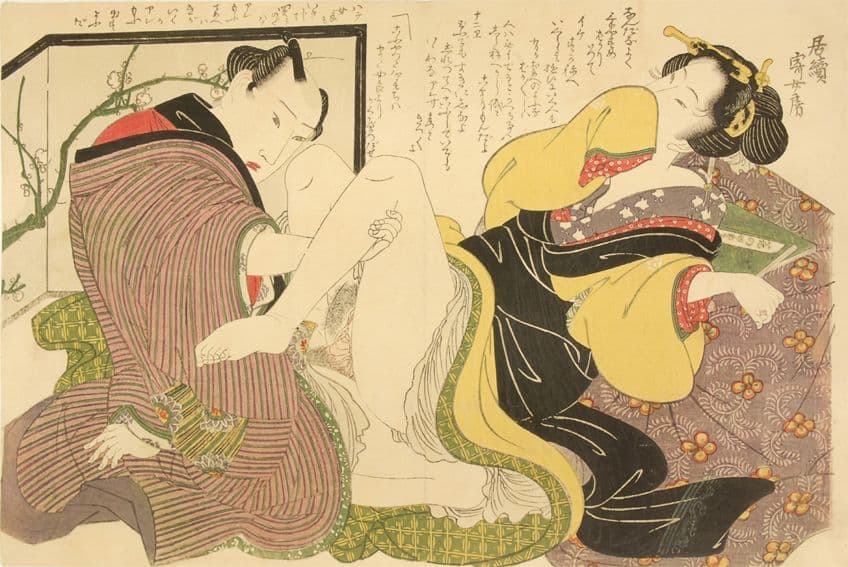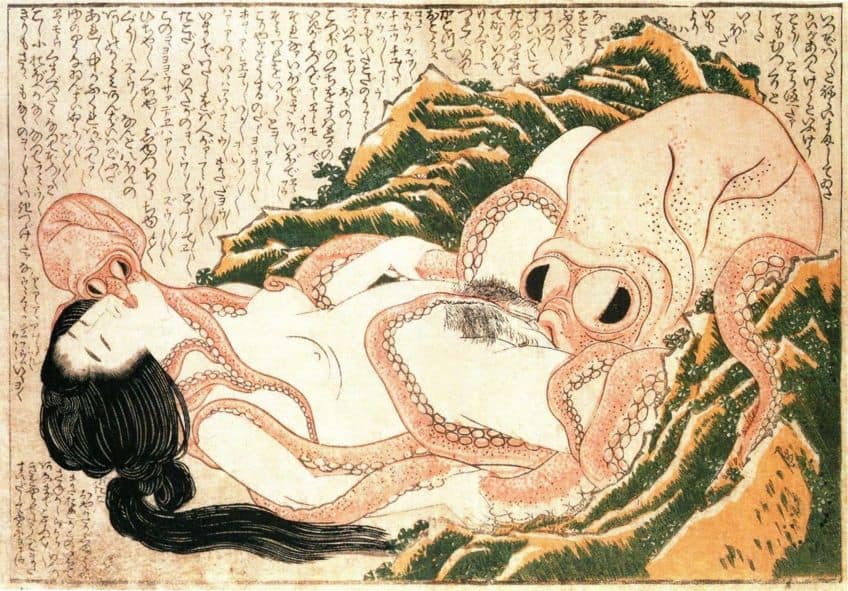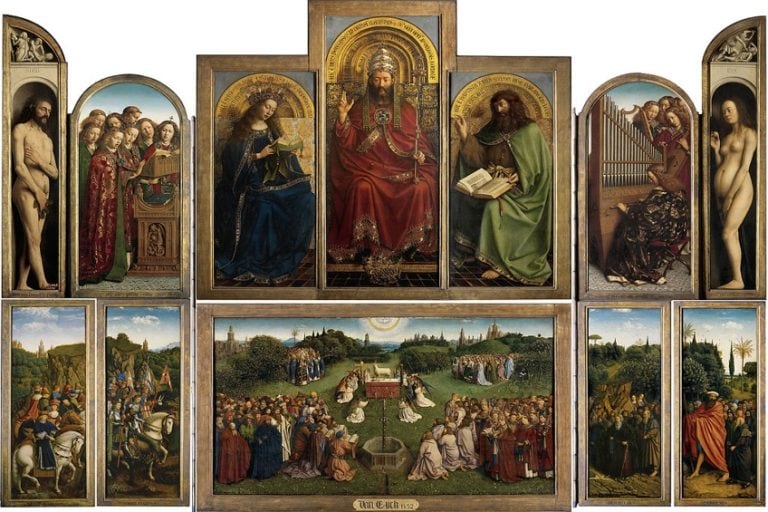Japanese Erotic Art Shunga – What Is Japanese Shunga Art?
Japanese shunga is a kind of sensual art that is primarily created using woodblock prints known as ukiyo-e. The Japanese erotic art, Shunga, translates to a “picture of spring”, which is a term commonly used to allude to sex in Japanese culture. In spite of being disapproved of by the military government, this ancient Japanese erotic art form was popular with all social classes during the Edo period. These erotic Japanese paintings featured scenes of everyday Japanese life and depicted sexuality in a variety of ways.
Understanding Japanese Erotic Art – Shunga
Starting in the Muromachi era, pictures in Chinese medicinal books profoundly inspired Shunga. Zhou Fang, a well-known Tang-dynasty Chinese artist, is also believed to have had an impact. He drew genital parts in an exaggerated style, comparable to a frequent shunga topos, as did many other painters of his day. Shunga is also a shortening of shunkyū-higi-ga, the Japanese name for a set of 12 Chinese scrolls showing the 12 sexual activities that the heir to the throne would undertake to represent yin and yang.

The History of Japanese Shunga
Shunga’s Japanese origins stretch back to the Heian era. It was observed among the courtier elite during this era. Sexual scandals from the imperial court or monasteries were portrayed using the medium of narrative handscrolls, and the subjects tended to be restricted to royals and monks. The Edo era marked the height of the style. The number and quality of woodblock printing processes rose substantially. The earliest official attempt to curb shunga was an order released by the Tokugawa shogunate in 1661, which prohibited, among several other things, pornographic literature known as kōshokubon.
Whereas other categories covered by the decree, such as pieces criticizing samurai, were forced underground, the Japanese erotic paintings continued to be created with minimum disruption.
The Kyōhō Reforms, an order issued in 1722, were far harsher, prohibiting the creation of all new publications except if the city commissioner granted permission. Japanese Shunga went underground after this order. Nevertheless, since publishing guilds felt appropriate to send their members periodic cautions not to sell erotic Japanese paintings for several decades after this decree, it is likely that manufacture and sales continued to thrive. The Kansei Reforms of Emperor Kkaku in the 1790s introduced even more measures to limit the manufacture of Japanese erotic paintings. Japanese shunga also encountered difficulties in Western museums during the 20th century.

According to Peter Webb, while conducting research for a publication, he was originally told that no applicable content existed in the British Museum, and when eventually granted access to it, he was told that it “could not conceivably be displayed to the public” and had not been cataloged. He returned to the institution in 2014, when an exhibition of ancient Japanese erotic art was being proudly exhibited. The arrival of Western culture and technology at the start of the Meiji era, notably photo-reproduction methods, had major ramifications for shunga. For a while, woodblock printing was still utilized, but characters wearing Western attire and haircuts started to feature in prints. Japanese erotic paintings eventually couldn’t compete with sexual photography, resulting in their demise.
The Uses of the Japanese Erotic Art – Shunga
Japanese shunga was most likely appreciated by both men and women of all social strata. Superstitions and practices around shunga imply as much; just as carrying shunga was thought to be a fortunate charm against death for a samurai, it was thought to be a shield against fire in trade warehouses and the household. We may surmise from this that the chonin, samurai, and housewives all possessed erotic Japanese paintings. The samurai resided in barracks for long periods of time, and separation from loved ones occurred as a result of the sankin-kotai system and merchants’ need to commute to purchase and sell commodities. As a result, it has been suggested that shunga possession was libidinous rather than superstitious.
Women were regular consumers of erotic Japanese paintings, according to records of women receiving them from book lenders.
Shunga may also have provided sexual counseling to affluent families’ boys and daughters. The educational efficacy of shunga has been disputed since the difficult poses and lack of method description restrict its educational value, and there were sexual texts in circulation that gave better instructions, including tips on cleanliness. The quality and price of Shunga varied considerably. Some were extremely detailed, and commissioned by affluent merchants, while others were restricted in color, readily available, and inexpensive. Some were available through lending libraries, known as kashi-honya, which traveled around rural regions. This indicates that shunga permeated all social classes.

The Production of Japanese Erotic Paintings
Shunga was created by ukiyo-e painters between the 16 and 19th centuries because they were bought more easily and at a greater price than their regular artwork. Japanese shunga prints were manufactured and distributed as single sheets or, more often, in booklet form, known as enpon. These used to feature 12 pictures, a practice rooted in Chinese shunkyu higa. Shunga was also available in hand scroll style, known as kakemono-e. This type was also common, however, it was more expensive because the scrolls had to be painted separately. The caliber of shunga art fluctuates, and few ukiyo-e artists dabbled in it. Experienced artists discovered that concentrating on their own output was more advantageous.
This resulted in the use of shunga by well-known painters, such as the ukiyo-e artist whose work is arguably best known in Western countries, The Dream of the Fisherman’s Wife (1814) by Hokusai.
These artworks provided a steady income for Ukiyo-e painters, and crafting a piece of shunga for a high-ranking customer might provide them with enough money to live on for roughly six months. In the late 20th and early 21st centuries, world-famous Japanese artists such as Hajime Sorayama employ their particular hand-brush painting style and Hanko stamp signature technique to produce contemporary Japanese shunga art in the spirit of historical painters such as Hokusai. Although full-color printing first appeared about 1765, many shunga prints precede this. Prior to this, color was applied by hand to monochrome prints, and beginning in 1744, benizuri-e permitted the manufacture of prints with restricted colors.

Numerous shunga prints were created using older processes even after 1765. In some circumstances, this was done to keep costs down, but in many cases, it was a matter of personal preference. Edo shunga tends to be more vividly colored than Osaka and Kyoto shunga, due to a divergence in aesthetic preference between these regions – Edo promotes innovation and luxury, while the Kamigata area prefers a more subdued style. This also meant more background details in Edo Shunga.
Content of the Japanese Erotic Art – Shunga
Shunga from the Edo era attempted to represent a diverse spectrum of potential sexual possibilities. Some scholars on the subject describe this as the development of a world that is exaggerated, eroticized, and exotic in comparison to modern urban life. The vast majority of Japanese erotic paintings portray sexual relationships between ordinary people, the chonin, townspeople, the merchant class, women, craftsmen, and farmers. There are also foreigners from Portugal and the Netherlands. Many Japanese shungas also featured courtesans as their subjects.
The representations of courtesans by Utamaro, which provided an unparalleled level of compassion and psychological subtlety, were highly admired.
Men considered courtesans to be extremely eroticized as a result of their occupation, but also unreachable, since only the richest, most sophisticated men would have any chance of engaging in sexual intercourse with one. Women regarded them as remote, glamorous figures, and courtesan attire influenced Japanese fashion throughout the country. Due to these factors, many people were drawn to the courtesan fetish. Courtesan paintings have been criticized for conveying an idealized depiction of daily life in the pleasure districts.

It has been alleged that they obscured the sex workers’ status of actual slavery. Utamaro, on the other hand, is only one instance of an artist who was attentive to the inner lives of the courtesan, for instance, representing them longingly dreaming of escaping Yoshiwara by marrying someone. Rather than a planned narrative, painted handscrolls and illustrated erotic novels frequently featured an unconnected succession of sexual tableaux. Men would be depicted seducing women, women seducing men; both sexes cheating on each other; all ages, from virginal youths to old husbands and wives; even sea creatures were occasionally portrayed.
Shunga was immensely popular in East Asia. Almost all great ukiyo-e painters created erotic artwork. Despite being prohibited by the government, they were distributed anonymously under the counter and are believed to account for up to half of ukiyo-e output at that time. The Japanese attitude toward sexuality differed greatly from that of Europe, where sensuality had been veiled with heroic and sacred meanings. European artwork was largely concerned with the nude female figure. A carefree approach to sex is important to Japanese culture. Philosophy, religion, and medicine are frequently utilized as metaphors in ancient Japanese erotic art.
Frequently Asked Questions
What Was Japanese Shunga Used For?
Shunga art represented sexual activities and was frequently used as a means to increase sexual pleasure. The principal application of shunga would have been to examine and share artworks or literature with sex partners or close friends. The erotic Japanese paintings were also used to teach young couples about sexuality or to urge a warrior to fight. They appear to have been highly prized by ladies, as they were discovered among the marital items handed to a Japanese bride. Shunga was generally produced in the form of paintings and woodblock prints, and was either presented as a gift or enjoyed personally. Shunga was commonly displayed publicly in the house, and it was regarded as a regular and acceptable kind of art.
Are the People in Japanese Shunga Naked?
The characters in virtually all shunga are completely dressed. People in Japan were accustomed to observing the opposite sex naked in community baths, thus nudity was not intrinsically erotic. The apparel also assisted the reader in identifying courtesans and outsiders, as the prints frequently held symbolic significance, and they attracted attention to the exposed portions of the body, particularly the genitalia. Shunga lovers are frequently shown in unnatural poses with enlarged genitalia. This has an intriguing explanation: it boosted the visibility of sexually explicit material.
Isabella studied at the University of Cape Town in South Africa and graduated with a Bachelor of Arts majoring in English Literature & Language and Psychology. Throughout her undergraduate years, she took Art History as an additional subject and absolutely loved it. Building on from her art history knowledge that began in high school, art has always been a particular area of fascination for her. From learning about artworks previously unknown to her, or sharpening her existing understanding of specific works, the ability to continue learning within this interesting sphere excites her greatly.
Her focal points of interest in art history encompass profiling specific artists and art movements, as it is these areas where she is able to really dig deep into the rich narrative of the art world. Additionally, she particularly enjoys exploring the different artistic styles of the 20th century, as well as the important impact that female artists have had on the development of art history.
Learn more about Isabella Meyer and the Art in Context Team.
Cite this Article
Isabella, Meyer, “Japanese Erotic Art Shunga – What Is Japanese Shunga Art?.” Art in Context. March 24, 2023. URL: https://artincontext.org/japanese-erotic-art-shunga/
Meyer, I. (2023, 24 March). Japanese Erotic Art Shunga – What Is Japanese Shunga Art?. Art in Context. https://artincontext.org/japanese-erotic-art-shunga/
Meyer, Isabella. “Japanese Erotic Art Shunga – What Is Japanese Shunga Art?.” Art in Context, March 24, 2023. https://artincontext.org/japanese-erotic-art-shunga/.










